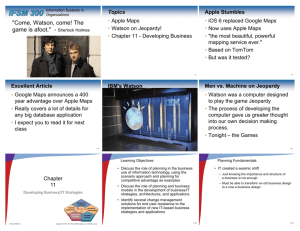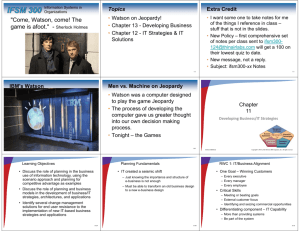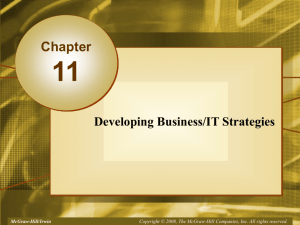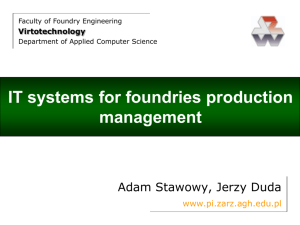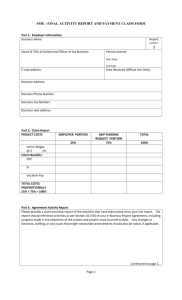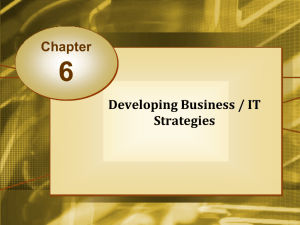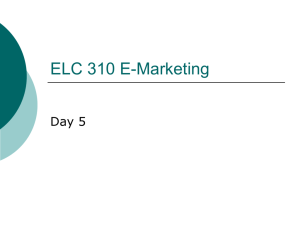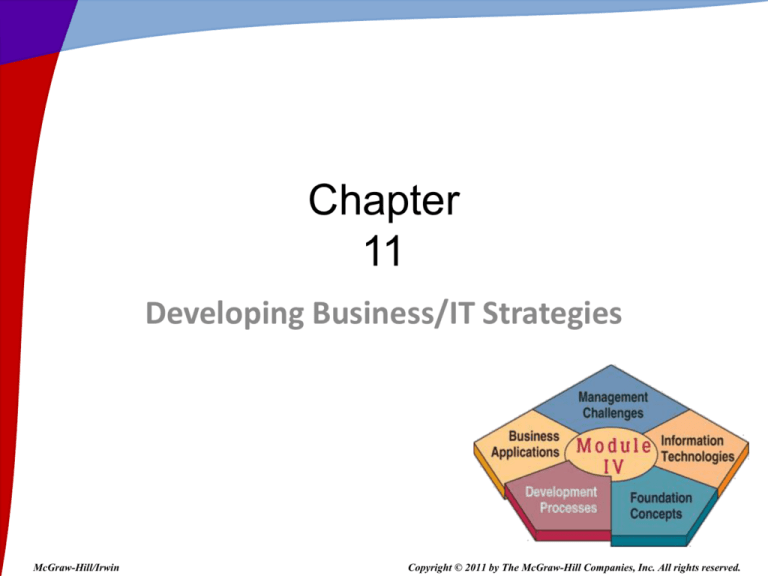
Chapter
11
Developing Business/IT Strategies
McGraw-Hill/Irwin
Copyright © 2011 by The McGraw-Hill Companies, Inc. All rights reserved.
Learning Objectives
• Discuss the role of planning in the business
use of information technology, using the
scenario approach and planning for
competitive advantage as examples
• Discuss the role of planning and business
models in the development of business/IT
strategies, architectures, and applications
• Identify several change management
solutions for end user resistance to the
implementation of new IT-based business
strategies and applications
11-2
Planning Fundamentals
• IT created a seismic shift
– Just knowing the importance and structure of
e-business is not enough
– Must be able to transform an old business design
to a new e-business design
11-3
RWC 1: IT/Business Alignment
• One Goal – Winning Customers
– Every executive
– Every manager
– Every employee
• Critical Skills
– Meeting or beating goals
– External customer focus
– Identifying and seizing commercial opportunities
• Differentiating component – IT Capability
– More than providing systems
– Be part of the system
11-4
Components of Organizational Planning
11-5
Scenario Approach
• Gaining popularity
• Less formal
• Virtual world (microworld) exercises
• Business scenarios are created and evaluated
• Alternative scenarios are then created
11-6
Strategic Visioning Questions
11-7
Trends that Affect Strategic Planning
11-8
Strategic Opportunities Matrix
11-9
SWOT Analysis
• Strengths
– Core competencies and resources
• Weaknesses
– Areas of substandard business performance
• Opportunities
– Potential for new business markets or innovative
breakthroughs
• Threats
– Potential for business and market losses
11-10
Business Models and Planning
• Vital questions
– Who are our customers?
– What do our customers value?
– How much will it cost to deliver that value?
– How do we make money in this business?
11-11
Questions for Business Models
11-12
The Business/IT Planning Process
11-13
Information Technology Architecture
• Conceptual design components
– Technology platform
– Data resources
– Application architecture
– IT organization
11-14
Balanced Scorecard
• Measures activities in terms of vision and
strategies
– Financial performance
– Impact on customers
– Performance of key business processes
– Company’s learning curve and growth
• Four processes
– Translate vision into operational goals
– Communicate vision and link to performance
– Business planning
– Feedback/learning and strategy adjustment
11-15
Balanced Scorecard Example
www.steelwedge.com
11-16
Identifying Business/IT Strategies
• Valuable Internet applications
– Transcend communication barriers
– Establish connections that enhance productivity
– Stimulate innovative development
– Improve customer relations
11-17
Strategic Positioning Matrix
11-18
Strategic Matrix
• Cost and Efficiency Improvements
– Low internal and low external connectivity
– Recommend – Use the Internet as a fast, low-cost
way to communicate and interact with others
• Performance Improvement in Effectiveness
– High internal but low external connectivity
– Recommend – Increase use intranets and
extranets
11-19
Strategic Strategies
• Global Market Penetration
– High external but low internal connectivity
– Capitalize with e-commerce websites using
value-added information services and extensive
online customer support
• Product and Service Transformation
– High external and high internal connectivity
– Develop and deploy new Internet-based
products and services to create a new strategic
position in the marketplace
11-20
E-Business Strategy Examples
•
•
•
•
•
•
•
Market Creator
Channel Reconfiguration
Transaction Intermediary
Infomediary:
Self-Service Innovator
Supply Chain Innovator
Channel Mastery
11-21
Business Application Planning Process
11-22
Comparing Planning Approaches
11-23
E-Business Architecture Planning
11-24
Implementation Challenges
• Implementation
– Do what you planned to do
– Critical skill for managers
• Many companies are good at planning
• Few are good at executing the plan
– Even if senior management consistently identifies
e-business as an area of great opportunity and
critical need
11-25
RWC 2: Project Success
• People skills critical to project success
– Teamwork
– Support during tough times
• Bad relationships leading cause of failure
• Managers tend to go to software instead of
building relations
• Showing progress at short intervals helps
11-26
Implementing Information Technology
• Developments that have generated
organizational change
–
–
–
–
–
–
–
–
Business process reengineering
ERP systems
Y2K compliance
Shared service centers
Just-in-time manufacturing
Sales force automation
Contract manufacturing
Introduction of Euro currency
• E-business is the latest catalyst
11-27
Impact and Scope of Implementing IT
11-28
Impact and Scope of Implementing IT
11-29
End User Resistance and Involvement
• Change generates resistance
• Examples:
– Customer Relationship Management (CRM)
– Knowledge Management Systems (KM)
• CRM failures
– CRM failure rate up to 75 percent
– Causes for failure
• Sales force automation problems
• Unaddressed cultural issues
• Sales staffs fearful and thus resistant
11-30
Obstacles to KM Systems
11-31
Keys to Solving End User Resistance
• Create relationships
– Understand the end-user’s situation
• Provide education and training
• Require involvement and commitment
– End-users
– Top management
– All stakeholders
• Eliminate frustration and inconvenience
11-32
Key Dimensions of Change Management
11-33
Change Management Programs
• Develop a change action plan
• Assign managers as change sponsors
• Develop employee change teams
• Encourage open communications and
feedback about organizational changes
11-34
Change Management Tactics
• Involve as many people as possible in ebusiness planning and application
development
• Make constant change an expected part of
the culture
• Tell everyone as much as possible about
everything, as often as possible, in person
• Make liberal use of financial incentives and
recognition
• Work within company culture, not around it
11-35
A Change Management Process
11-36
Avnet Marshall’s Transformation
11-37
RWC 3: Crucial Strategic Planning Elements
• Alignment between business and IT
– IT strategic plan to improve the business-IT
relationship
– Articulate how IT fits into business and overall
business strategy.
• Apply clear strategy to business activities
11-38
RWC 4: The Science behind Change
• Implementing changes is very challenging
• Employees resist change
• Understanding can lead to smoother
transitions
• Not everyone is motivated by ambition
• Education and training aid with acceptance
11-39

